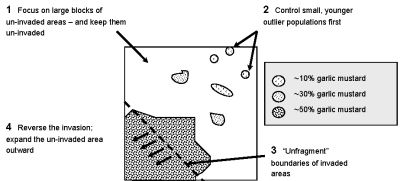It’s important to think through a plan for managing invasive plants on your land before you launch an attack. Without a plan, it’s easy to underestimate the time and resources it will take to control a species. You can end up overwhelmed and give up in frustration.
An important part of planning is to prioritize the work ahead of you, deciding what species you should start on first, and where you should begin. That way, at least you’ll know that what you did accomplish was more important than what you didn’t have time or resources to complete.
Prioritizing by Species
You walk through your woodlot and wince when you see the garlic mustard, which looks likes it’s spread considerably since last year. Then you notice the burning bush shrubs in the understory and realize your neighbor’s landscaping has made itself at home in your woods. And that vine….those orange berries…geez, where did the oriental bittersweet come from?!
Like potato chips, it seems nobody can have just one invasive plant species. There are usually multiple species invading a given area, which can make the job of managing a site much more difficult. Where do you start when you have more than one species to deal with?
A lot of us have struggled with this, and fortunately there are some easy rules to help sort out which species to go after first. What follows is a simplified version of a prioritization template created by The Nature Conservancy. More tools from The Nature Conservancy
Before you start prioritizing, though, you need to know three things:
Know what you have.
Use a good field guide or a knowledgeable botanist friend to double-check that you’ve identified a real invasive plant rather than an innocent look-alike.
Know how much you have.
The priority you place on 50 plants of garlic mustard will be very different from 5 acres of garlic mustard, as you’ll see in a moment. Map the invasive plants, circling each area of infestation and estimating what percent within the circled area is invasive species versus native. A handy way to do this is to use Google Earth to zoom in on your property and print out an aerial photo. Draw your property boundary on the aerial, then walk through your property in a grid-like fashion and mark what you see. Those of you with GPS units and GIS software on your computers are welcome to do it the high-tech way.
Know what you want.
This may be very easy for you, or very difficult. What do you most want to protect on your land? Is it the ovenbirds that nest there? The bluebells that bloom each spring by the creek? The deer habitat? The ability to walk through the woods without having to fight thorny shrubs? Deciding what you want to manage your land for is important. Think this through, and even map the areas you most want to protect against invasive plant species.
Now you’re ready.
Assigning Top Priority
The following four questions will tell you which species should be your top priority. You should already know the answers to number one and two from figuring out above how much you have and what you want to protect. Numbers three and four are answered by reading information about each invasive species or talking to professionals who work with invasive species in your area.
For each species, answer these questions and add the points:
1. How much do you have?
1 pt—I don’t have any, but it’s near my land
2 pt—Just a small amount, but it’s spreading
3 pt—A fair amount, and it’s still spreading
4 pt—A LOT! It’s covering the whole area completely
2. What’s the value of the habitat being invaded?
1 pt—It’s invading my favorite area that has the stuff I want to protect
2 pt—It’s invading the disturbed edge or areas that I don’t care as much about
3. What impacts is it causing?
1 pt—All is lost; it changes the area so much that few species survive
2 pt—It invades undisturbed areas and outcompetes native species
3 pt—It doesn’t outcompete native species, but natives don’t regenerate
4 pt—It invades disturbed areas like edges
4. How hard is it to control?
1 pt—Not too bad; one treatment and it’s pretty much gone
2 pt—Takes multiple treatments, but eventually it’s gone and natives replace it
3 pt—Takes multiple treatments and natives don’t come back in readily
4 pt—No effective treatment has been found
Now add the total points for each species. The lower the score, the higher the priority.
To summarize it another way—cheap and easy is often your top priority! It is common to be mesmerized by the acres of garlic mustard in bloom and completely miss the one oriental bittersweet vine that snuck in while you weren’t looking.
If you have unlimited time and money, congratulations! Hire a big crew and go after them both. If, like most of us, you have limited time and money, turn your back on the garlic mustard and kill the oriental bittersweet. Nipping it in the bud, so to speak, means you can spend a small amount of time and money and keep it from becoming a huge infestation a few years from now. When it’s dead, then go work on the garlic mustard.
Prioritizing at the Site
Alright, you say bravely, the oriental bittersweet vine is dead and I’m ready to tackle this huge area of garlic mustard. But it’s a big project, and I’m not sure where to start. Here are a few more rules of thumb to help prioritize where to work first at a site.
First, identify and map invaded and un-invaded areas as shown below (that’s a map of my woods). Then follow steps 1 through 4.
Controlling invasive plants can be challenging, but prioritizing your battles before you begin will make your success much more likely. Go get ‘em!
Reprint of an article that appeared in the Summer 2009 INPS Journal by Ellen Jacquart, Chair, INPS Invasives Education Committee.

